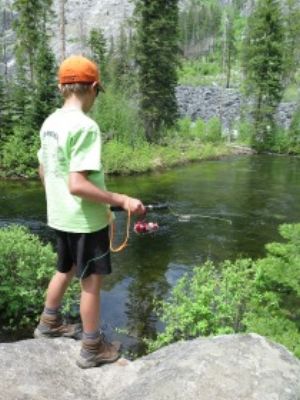Most of us have never needed to catch a fish to save our life. Finding food in a survival situation, whether hunted, fished or foraged, is nothing more than a accountant’s balance sheet where calories are added and subtracted all day long, and you are the accountant.
by Doc Montana, a contributing author of SurvivalCache.com
Calories = Survival
Just as a business cannot survive long when operational costs exceed income, neither can you. Life requires energy so your motor is always  running whether or not you are doing anything productive. And since your survival clock is ticking, you must constantly maintain a cost/benefit analysis for everything you do. If you spend more energy acquiring food than the food contains, you are losing the battle. Consume more energy than you expend and you store some of it in often non-flattering places for later.
running whether or not you are doing anything productive. And since your survival clock is ticking, you must constantly maintain a cost/benefit analysis for everything you do. If you spend more energy acquiring food than the food contains, you are losing the battle. Consume more energy than you expend and you store some of it in often non-flattering places for later.
It’s easy to romanticize survival fishing. On a warm afternoon under a blue sky, there you are standing alone on a rock overlooking a gorgeous mountain lake filled with hungry fish just itching to strike anything you toss in the water. An hour later you walk back to camp a hero raising your stringer choked with blue ribbon trout. Or perhaps you fancy yourself a Tom Sawyer using no more than a willow branch and worm to catch your dinner.
Related Article: Adrift, Seventy Six Days Lost at Sea
The grim reality of the situation is that just sitting on the riverbank Tom is burning about one calorie per minute (assuming he is an average 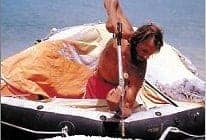 12 year old boy of 5 feet and 95 pounds). When Tom pulls a fish from the water, depending on the size of the fish, Tom just bought himself several hundred more minutes of life. But if Tom was standing in the cold river fly fishing, or repeatedly casting and reeling in a spinner, or ice fishing, the same catch might go only half as far in life minutes. The calories required to catch the fish must be subtracted from the survival benefit of eating it. To put it bluntly, when Tom burns more calories catching the fish than are in the fish, Tom is dying.
12 year old boy of 5 feet and 95 pounds). When Tom pulls a fish from the water, depending on the size of the fish, Tom just bought himself several hundred more minutes of life. But if Tom was standing in the cold river fly fishing, or repeatedly casting and reeling in a spinner, or ice fishing, the same catch might go only half as far in life minutes. The calories required to catch the fish must be subtracted from the survival benefit of eating it. To put it bluntly, when Tom burns more calories catching the fish than are in the fish, Tom is dying.
 Of course this game of numbers is not like a parking meter where you’re OK one minute, then expire the next. But it’s still a game. A 10-inch trout, eyeballs and all, is about 200 calories, or about three hours of adult basal metabolic activity (BMA). The BMA is your energy consumption at rest. It is a combination of the energy used for life processes such as stoking your furnace (thermogenesis), respiration, digestion, and the fuel burned in your muscles. Additional factors come into play including level of fitness, ambient temperature, medical constraints, stress, and hydration level, all of which are key components in how efficiently the rest of the body systems can function.
Of course this game of numbers is not like a parking meter where you’re OK one minute, then expire the next. But it’s still a game. A 10-inch trout, eyeballs and all, is about 200 calories, or about three hours of adult basal metabolic activity (BMA). The BMA is your energy consumption at rest. It is a combination of the energy used for life processes such as stoking your furnace (thermogenesis), respiration, digestion, and the fuel burned in your muscles. Additional factors come into play including level of fitness, ambient temperature, medical constraints, stress, and hydration level, all of which are key components in how efficiently the rest of the body systems can function.
Doing the math, you would have to catch, cook, and consume one small to medium sized fish every two or three hours around the clock to maintain a sustainable life at your current weight. Of course you likely entered this survival situation with a week or two’s worth of energy stored as fat, but the body’s power company has the energy bill on direct pay so there is absolutely nothing you can do to stop burning calories. Welcome to how the other 99.999 percent of life on the planet lives.
Related Article: The Survival Edibility Test
This might seem outrageous at first, but remember that you are eating nothing but fish. No butter. No rice. No salad. No high calorie desserts. Nothing but low-fat protein-rich flesh and calcium. Frankly, even if you could pull enough slime rockets (fish) from the water, you will likely succumb to protein poisoning in a week or two. Which brings up another important point in that you cannot spend all your time fishing. You must supplement your diet which means your fishing must be as fast and effective as possible.
Enter the Survival Fishing Rod
The small sardine-can sized survival fishing kits are great for short term situations. And don’t worry, the irony of storing emergency fishing 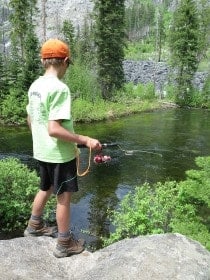 supplies in a can that normally holds fish has not escaped me. But seriously, for brief survival episodes most folks would do better to carry around a can of fish in their back pocket instead of a fishing kit. And make it the oiliest, saltiest fish you can find with sardines in olive oil yielding more than two calories per gram while canned tuna in brine is about one to one.
supplies in a can that normally holds fish has not escaped me. But seriously, for brief survival episodes most folks would do better to carry around a can of fish in their back pocket instead of a fishing kit. And make it the oiliest, saltiest fish you can find with sardines in olive oil yielding more than two calories per gram while canned tuna in brine is about one to one.
It’s true that any caloric income is better than none. The problem is that the calories beyond your BMR that you spend catching the fish, whether by struggling with a lack of proper equipment, crawling around on rocks, wading in the water, standing exposed to the elements, or crashing through brush to get close to the deeper pools, is like a tax on the fish. The trout is still worth 200 calories, but you just spent 250 calories in time and effort to catch it. In other words, you will live longer by laying quietly on the shore enjoying the view than by fishing.
Approximate weights of trout:
8 inch trout = 4 ounces
10 inch trout = 7 ounces
12 inch trout = 1 pound
15 inch trout = 1.5 pounds
*as listed in the book “The Lost Lore of a Man’s Life” by Denis Boyles.
Survival Super Powers
If fish are plentiful, compared to a string, bobber and hook, the Emmrod survival fishing rod may give you the super-human power to catch 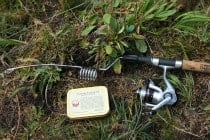 a fish every 15 minutes or so, and likely larger fish as well due to the Emmrod’s casting distance and accuracy. So now the survival problems have moved downstream to food preparation and storage. By catching three 10 inch fish in 45 minutes you just bought nine hours of time to do other things. Sure, that’s a best case of a worst case, but in other words, the Emmrod can save your life and the lives of those counting on you of whom the sardine can fishing kit has long forgotten about.
a fish every 15 minutes or so, and likely larger fish as well due to the Emmrod’s casting distance and accuracy. So now the survival problems have moved downstream to food preparation and storage. By catching three 10 inch fish in 45 minutes you just bought nine hours of time to do other things. Sure, that’s a best case of a worst case, but in other words, the Emmrod can save your life and the lives of those counting on you of whom the sardine can fishing kit has long forgotten about.
Related Article: Emmrod Fishing Pole Review
However…and there is always a however, the survival fishing supplies stored insides a sardine can are light years ahead of having to build your tackle box from scratch. Every Bug Out Bag should have a Fishing Can as an essential emergency backup for when rescue or escape is likely. Perhaps days or even weeks away, but still likely. But for those longer events, or where there is more to the SHTF than meets the eye, fishing has been a survival solution since Biblical Times.
And thus enters the reality of a life-saving survival fishing rod. Compared to sardine-can fishing, the additional metabolic fuel requirement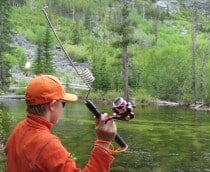 above BMR when using the Emmrod is so low to be of little concern in the calorie equation. Where the good numbers do go up, and way up at that, is with casting frequency, casting distance, and casting accuracy.
above BMR when using the Emmrod is so low to be of little concern in the calorie equation. Where the good numbers do go up, and way up at that, is with casting frequency, casting distance, and casting accuracy.
A major point of consideration that armchair survival fisherman fail to consider is just how hard it is to hook a fish with only a line in hand. Detecting a strike is one thing, but setting a hook and keeping it there is quite another. A major reason good fishing rods cost so much is their flex response and sensitivity. Half of the money you pay for a fishing rod is for casting, and the other half is for setting the hook during a strike. Having some mono-filament wrapped around your numb fingers or a piece of driftwood is nearly impossible to cast, and the fish will come and go before you can yank up enough slack to secure the barb into fish flesh. Sure, we’ve heard the stories about the successful fisherman using little more than a safety pin, a piece of string, and a beer can for a reel, but that is not ideal anymore than is a slingshot when you could have a Glock.
The Emmrod, for all it’s simplicity, is actually a sophisticated design and was engineered with an action that easily rivals traditional-length poles. The action of a fishing rod is where or how the rod bends under load. Some rods bend progressively across their entire length, while others bend significantly more at the tip. Another confusing variable that is often mixed into discussions about rod action is actually rod power. The power of a fishing rod describes the rod’s overall stiffness or the amount of bend in the rod under a given load. So action is the shape of the bend, and power is the amount of bend. A light action rod would bend much more at the tip, while a heavy action would curve throughout its length. A less powerful rod would bend much more than a more powerful rod under the same load.
Through the use of patented stainless steel “Power Coils” the action and power of the Emmrod casts, twitches and reels much like a longer 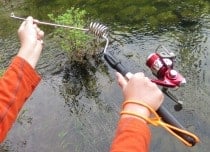 pole. The size of the Power Coils is a variable when buying an Emmrod and is dependent upon your anticipated use. A size 4 coil behaves like a heavy action rod and would work for bigger fish up to 20 pounds. A size 6 coil is a medium heavy action for fish up to 15 pounds. And a size 8 coil has a light action for smaller fish or those under five pounds. The in-house casting standard for an Emmrod is a 100-foot throw with a quarter ounce weight. Compare that to what you can do hand-casting a line.
pole. The size of the Power Coils is a variable when buying an Emmrod and is dependent upon your anticipated use. A size 4 coil behaves like a heavy action rod and would work for bigger fish up to 20 pounds. A size 6 coil is a medium heavy action for fish up to 15 pounds. And a size 8 coil has a light action for smaller fish or those under five pounds. The in-house casting standard for an Emmrod is a 100-foot throw with a quarter ounce weight. Compare that to what you can do hand-casting a line.
But none of this matters in a survival situation if your 8-piece carbon fiber survival fly rod is in splinters at the bottom of your bug out bag. Having the proper action and power for a particular situation is of little consequence when you are forced to fish for your life. So let’s look at the survival fishing rod from another perspective by adding fishing efficiency to the equation. If your handmade branch-fishing rod requires you to wade into the cold water, or crawl around on the rocks to avoid scaring the fish, or repeatedly spend valuable time fighting with your line, then your equipment is working against you. Now replay this same scenario hour after hour, day after day and it doesn’t take an accountant to see that your checking account at First National Life will soon be overdrawn.
Other attempts at compact rods have worked, but either not for long or not well at all. Multi-piece rods require care, assembly, and if a piece 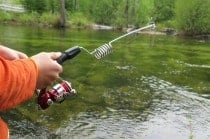 goes missing or more likely stepped on or crushed in a car door, the rod is only as long and thus as good as its longest part. Telescoping rods work but loosen up or crack when used repeatedly. Short ice fishing rods reel in just fine, but cast like a yo-yo. And there is the famous Ronco Pocket Fisherman. What’s not seen on TV is that regardless of the cult following of this micropole, it has the action of a toy, and is just as fragile.
goes missing or more likely stepped on or crushed in a car door, the rod is only as long and thus as good as its longest part. Telescoping rods work but loosen up or crack when used repeatedly. Short ice fishing rods reel in just fine, but cast like a yo-yo. And there is the famous Ronco Pocket Fisherman. What’s not seen on TV is that regardless of the cult following of this micropole, it has the action of a toy, and is just as fragile.
A survival situation is not the time to look at your equipment and ask yourself if this is better than nothing? You had your chance. If you’re prepared, then you got to hand-pick your final decisions long before now. Right? Luckily the Emmrod is one of those wonderful survival tools that can be used daily as well as perform to mythical proportions when called upon to save your life.
The Balance Sheet of Life
The Emmrod Packrod can balance the flow of calories by providing a low-energy alternative to the willow branch. Compared to casting a wooden switch, the Emmrod can throw line farther and with much less energy. It can place the lure or bait closer to your target area, and it can retrieve the fish much more efficiently and reliably. To put it frankly, the Emmrod can buy you more life for less money than the price of a half-dozen MREs.
The Emmrod company is not some big city outfit that outsources all its work to China. Instead it is a family-owned outfit in northern Idaho 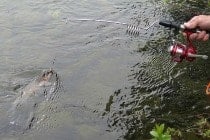 whose one-year warranty seems to really be a lifetime. Emmrod rods are assembled in-house, but the materials are sourced from many locations in order to ensure the highest quality. With global sales averaging around 12,000 units, the smalltown flavor of quality and workmanship can still permeate the Emmrod.
whose one-year warranty seems to really be a lifetime. Emmrod rods are assembled in-house, but the materials are sourced from many locations in order to ensure the highest quality. With global sales averaging around 12,000 units, the smalltown flavor of quality and workmanship can still permeate the Emmrod.
As a lifelong fisherman who routinely angles along the one and only “River that runs through it,” I am keenly aware of the degrees of quality and performance across equipment. I’ve fought fish with a pink $12.99 Barbie rod and reel kit, as well as with a custom hand-made fly rod complete with a reel that cost more than my first car and line that cost more than my first hunting rifle. And I’ll be honest. When I first saw a picture of the Emmrod, I thought in an SHTF I could build one of those out of a coat hanger and a broom handle. And of course I could, but it would be an exercise in futility. The Emmrod is actually simple like a iPhone is simple. When you use it the device disappears into the experience. The engineering and materials make the Emmrod melt into your hand much like a full sized fishing pole.
And to make survival matters worse for traditional rods, or better if you have an Emmrod, is that you can cast a line using the powercoils alone. Just prepare your reel for a cast, then pull back the tip at the end of the rod using the spring like a catapult. Release the spring and watch your lure sail out into the water. You can do this one handed with the rod under your other arm, between your knees, or even standing on the handle. So why would you do this? Imagine having a injury, or limited space. The Emmrod could be wedged in the crack of a rock and cast with your foot. Of course by that point your SHTF is a real double-flusher. Practice is recommended since the coordination for a successful spring-cast is a notch or two above traditional casting. Even a slight mistiming will cause a non-cast at best, shoot the lure sideways, or at the worst generate a rat’s nest of line around the reel.
Although the Emmrod works fine as a general purpose daily go-to rod, for those planning on long term survival storage, be aware that some  line conditioning is recommended before betting your life on your next cast. Spooled line has a strong memory of being in tight loops so without stretching out the first 20 or 30 yards of line for a few minutes, your initial casts will not be pleasant. But once you get the hang of the Emmrod’s tradeoffs, it makes an excellent rod that has significant advantages over poles three times it’s length. In fact the only absolute downside I found with its diminutive status is when guiding the line around snag hazards in the water. A longer pole gives you much more steering capabilities. Further should you snag the hook on an immovable object, the number of leverage points to fight the snag is limited to the smaller radius of pole swing.
line conditioning is recommended before betting your life on your next cast. Spooled line has a strong memory of being in tight loops so without stretching out the first 20 or 30 yards of line for a few minutes, your initial casts will not be pleasant. But once you get the hang of the Emmrod’s tradeoffs, it makes an excellent rod that has significant advantages over poles three times it’s length. In fact the only absolute downside I found with its diminutive status is when guiding the line around snag hazards in the water. A longer pole gives you much more steering capabilities. Further should you snag the hook on an immovable object, the number of leverage points to fight the snag is limited to the smaller radius of pole swing.
In some ways the Emmrod is like shooting a pistol compared to a traditional-length fishing pole being a rifle. The sight radius on the handgun is much shorter so successful aiming the cast with the Emmrod takes some practice. However, it is also much harder to snag on a tree above or behind you. All fishing is practice, so just consider the Emmrod a new technique that will take a few minutes to master. With that said, you may not want to hand over your Emmrod to a neophyte if your down to your last lure. Perhaps I’m making it sound a little tougher than it is, but just like a pistol, you are going to send metal downrange whether on target or not.
Final Casting
The elegance and simplicity of the Emmrod, like a fine survival knife, makes it the obvious choice after you’ve tried it. The cost seems within reason for a quality spinning rod and average reel. Even more, at about twice the price of a marginally useful fiberglass telescoping rod, the durability, simplicity, effectiveness, efficiency, and downright fun of the Emmrod makes the price pretty much a non-issue in the big picture.
Although I intentionally set out to shatter the romance of survival fishing, I hope I also stirred your romantic interest in the Emmrod because as far as equipping yourself for darker times, the Emmrod is truly something you can fall in love with.
by Doc Montana


